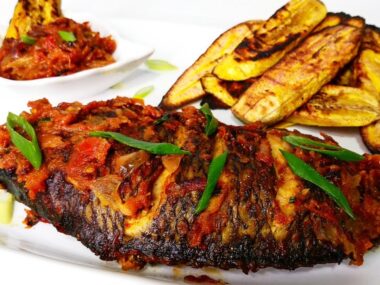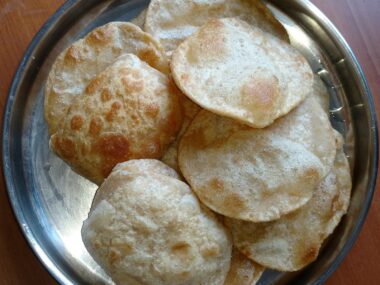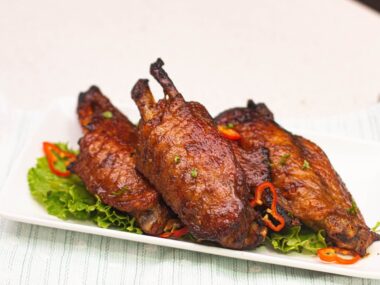Nigerian cuisine is renowned for its rich flavors, diverse ingredients, and deeply rooted cultural traditions. Among the many beloved dishes, the combination of beans and plantains stands out as a quintessential Nigerian afternoon meal. This simple yet nutritious pairing offers a perfect blend of taste and health benefits, making it a favorite across the country. In this extensive exploration, we delve into the historical context, nutritional advantages, preparation methods, and cultural significance of beans and plantains, showcasing why they remain an enduring staple in Nigerian diets.

Historical and Cultural Significance
Beans and plantains have been integral components of Nigerian cuisine for centuries. Their cultivation and consumption are deeply intertwined with the country’s agricultural practices and culinary traditions.
Beans (Ewa Riro)
Beans, particularly black-eyed peas and honey beans, have a long history in Nigerian agriculture. They are versatile legumes used in various traditional dishes, with Ewa Riro being one of the most popular preparations. Ewa Riro, a Yoruba term, translates to “stirred beans” and involves cooking beans in a rich, spicy tomato sauce.
Cultural Importance:
- Festive Dish: Ewa Riro is often prepared for special occasions, family gatherings, and festivals, symbolizing unity and hospitality.
- Comfort Food: This dish is considered comfort food for many Nigerians, providing warmth and nourishment, especially during cooler months.
Plantains (Dodo)
Plantains, a close relative of bananas, thrive in Nigeria’s tropical climate. They can be cooked in numerous ways, but fried plantains, known as dodo, are particularly cherished. Dodo is a staple in many Nigerian homes and is often served as a side dish or snack.
Cultural Importance:
- Daily Staple: Dodo is a regular feature in Nigerian meals, enjoyed by people from all walks of life.
- Street Food: Fried plantains are a popular street food item, sold by vendors in bustling markets and street corners.
Nutritional Benefits
The combination of beans and plantains provides a balanced and nutrient-rich meal. Both components are packed with essential nutrients that contribute to a healthy diet.
Nutritional Profile of Beans
Beans are a nutritional powerhouse, offering a wealth of proteins, fibers, vitamins, and minerals.
Key Nutrients:
- Protein: Beans are an excellent source of plant-based protein, crucial for muscle growth and repair.
- Fiber: High fiber content aids digestion, helps regulate blood sugar levels, and promotes a feeling of fullness.
- Vitamins and Minerals: Beans are rich in vitamins such as folate, and minerals like iron, magnesium, and potassium, which are vital for various bodily functions.
Health Benefits:
- Heart Health: The soluble fiber in beans helps lower cholesterol levels, reducing the risk of heart disease.
- Weight Management: Beans’ high fiber and protein content promotes satiety, aiding in weight management.
- Blood Sugar Control: Beans have a low glycemic index, making them suitable for individuals managing diabetes.
Nutritional Profile of Plantains
Plantains are not only delicious but also packed with essential nutrients that complement the nutritional profile of beans.
Key Nutrients:
- Carbohydrates: Plantains are a good source of complex carbohydrates, providing sustained energy.
- Vitamins: Rich in vitamins A and C, plantains support immune function and eye health.
- Minerals: High in potassium, plantains help maintain proper muscle function and electrolyte balance.
Health Benefits:
- Digestive Health: The fiber in plantains aids digestion and prevents constipation.
- Energy Boost: The complex carbohydrates in plantains provide a steady release of energy, making them ideal for an afternoon meal.
- Antioxidant Properties: Vitamins A and C act as antioxidants, protecting the body from free radical damage.
Preparation Methods
The preparation of beans and plantains can vary depending on regional preferences and personal tastes. Here, we explore some popular methods of preparing this nutritious combo.
Ewa Riro (Stewed Beans)
Ewa Riro is a traditional Yoruba dish made by stewing beans with a variety of spices and seasonings.
Ingredients:
- Black-eyed peas or honey beans
- Palm oil
- Onions
- Tomatoes
- Bell peppers
- Scotch bonnet peppers
- Crayfish (optional)
- Salt and seasoning cubes
Preparation Steps:
- Soaking and Cooking the Beans:
- Soak the beans overnight or for a few hours to reduce cooking time.
- Rinse and cook the beans in a pot of water until tender. This can take 1-2 hours depending on the type of beans.
- Making the Stew:
- Heat palm oil in a pot and sauté chopped onions until translucent.
- Add blended tomatoes, bell peppers, and scotch bonnet peppers to the pot.
- Cook the mixture until the oil begins to separate from the tomatoes, indicating that the sauce is well-cooked.
- Combining the Beans and Stew:
- Add the cooked beans to the stew and mix well.
- Season with salt, seasoning cubes, and crayfish (if using).
- Allow the mixture to simmer for an additional 15-20 minutes to let the flavors meld together.
Fried Plantains (Dodo)
Fried plantains, or dodo, are a popular side dish that pairs perfectly with Ewa Riro.
Ingredients:
- Ripe plantains
- Vegetable oil for frying
- Salt
Preparation Steps:
- Peeling and Slicing the Plantains:
- Peel the ripe plantains and slice them into desired shapes (rounds, diagonal slices, or sticks).
- Frying the Plantains:
- Heat vegetable oil in a frying pan over medium heat.
- Add the plantain slices to the hot oil, ensuring they do not overlap.
- Fry until golden brown on both sides, then remove and drain on paper towels to remove excess oil.
- Seasoning:
- Sprinkle a little salt over the fried plantains while they are still hot.
Serving Suggestions
Beans and plantains can be enjoyed in various ways depending on personal preference and regional customs.
Popular Serving Styles:
- Classic Combo: Serve a generous portion of Ewa Riro with a side of fried plantains. This combination is hearty and satisfying, making it an ideal afternoon meal.
- With Rice: Some people enjoy pairing Ewa Riro and fried plantains with steamed white rice or Jollof rice for a more substantial meal.
- Vegetable Sides: Adding a side of sautéed leafy greens, such as spinach or ugu (pumpkin leaves), enhances the nutritional value of the meal.
Variations and Regional Differences
Nigerian cuisine is diverse, and different regions have their unique twists on beans and plantains.
Yoruba Style Ewa Agoyin
Ewa Agoyin is a variant of stewed beans popular among the Yoruba people, particularly in Lagos. It is known for its unique preparation method and distinct flavor.
Key Features:
- Beans Preparation: The beans are cooked until very soft and mashed slightly.
- Pepper Sauce: The accompanying sauce is made with dried peppers, onions, and plenty of palm oil, resulting in a rich, spicy condiment.
Igbo Style Beans Porridge
In the southeastern part of Nigeria, the Igbo people prepare a version of beans porridge known as “Agwa na Oka”.
Key Features:
- Beans and Corn: This dish combines beans with fresh corn, adding a sweet and crunchy texture.
- Palm Oil and Vegetables: It is typically cooked with palm oil, onions, and vegetables such as spinach or ugu leaves.
Hausa Style Wake
In northern Nigeria, the Hausa people prepare a simple and nutritious beans dish known as “Wake”.
Key Features:
- Minimal Ingredients: The beans are cooked with minimal seasoning, often just salt and a little oil.
- Accompaniments: Wake is commonly served with masa (a type of rice cake) or fried plantains.
Cultural Rituals and Modern Adaptations
Beans and plantains hold a special place in Nigerian culture, often associated with various rituals and celebrations.
Festive Occasions
Beans and plantains are commonly prepared for festive occasions such as weddings, birthdays, and religious celebrations. They symbolize abundance and are enjoyed by people of all ages.
Street Food Culture
In Nigeria’s bustling street food scene, vendors selling fried plantains and beans dishes are a common sight. These street foods provide a quick, affordable, and nutritious option for people on the go.
Modern Adaptations
Modern Nigerian cuisine has seen innovative adaptations of traditional beans and plantains dishes. Chefs and home cooks alike experiment with different spices, cooking methods, and presentation styles to create contemporary versions of these classic dishes.
Examples:
- Baked Plantains: A healthier alternative to frying, baked plantains retain their sweet flavor with less oil.
- Bean Burgers: Blending cooked beans with spices and vegetables to form patties, bean burgers offer a creative twist on traditional beans dishes.
- Fusion Cuisine: Incorporating elements from other cuisines, such as adding coconut milk to Ewa Riro or serving dodo with avocado salsa.
Conclusion
Beans and plantains are more than just a meal; they are a cultural heritage, a source of nutrition, and a symbol of comfort and community for Nigerians. This nutritious combo embodies the essence of Nigerian cuisine—simple, flavorful, and deeply rooted in tradition. By understanding the historical context, nutritional benefits, preparation methods, and cultural significance of beans and plantains, we can appreciate their enduring appeal and relevance in contemporary Nigerian life.
Whether enjoyed at a festive gathering, as a comforting afternoon meal, or a quick street food snack, the combination of beans and plantains continues to nourish both body and soul, bridging the past with the present in the vibrant tapestry of Nigerian cuisine.










